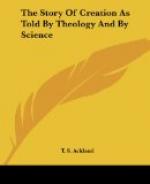Of these outer planets Jupiter, from his great brilliancy, specially attracts observation, while from his comparative proximity to the earth we are enabled to examine him much more satisfactorily than we can Saturn, Uranus, or Neptune. Two facts with reference to him have long been well known, the one, that the polar compression in his case is much greater than it is in any of the interior planets, so that when seen through a telescope of very moderate power his disc is evidently elliptical, while the compression of the interior planets can only be detected by the most delicate micrometrical measurements—the other, that his apparent surface is always crossed by several alternating belts of light and shade, which though subject to constant changes of detail, always preserve the same general character. Until recently the generally received theory was that these belts consisted of clouds, raised by the heat of the sun, and arranged in zones under the influence of winds similar in character to, and produced by the same causes as, the trade-winds which blow over our own oceans. This view, however, has been shown by Mr. Proctor to be untenable. [Footnote: See a paper by Mr. Proctor in the Monthly Packet for October, 1870.]
About forty years ago, a very remarkable phenomenon was observed simultaneously, but independently, by three astronomers, Admiral Smyth, Mr. Maclean, and Mr. Pearson, who were watching a transit of Jupiter’s second satellite from stations several miles apart. Admiral Smyth’s account of it is as follows:—“On Thursday, the 26th of June, 1828, the moon being nearly full, and the evening extremely fine, I was watching the second satellite of Jupiter as it gradually approached to transit the disc of the planet. My instrument was an excellent refractor of 3 3/4 inches aperture, and five feet focal length, with a power of one hundred. The satellite appeared in contact at about half-past ten, and for some minutes remained on the edge of the limb, presenting an appearance not unlike that of the lunar mountains which come into view during the first quarter of the moon, until it finally disappeared on the body of the planet. At least twelve or thirteen minutes must have elapsed when, accidentally turning to Jupiter again, I perceived the same satellite outside the disc. It was in the same position as to being above a line with the lower belt, where it remained distinctly visible for at least four minutes, and then suddenly vanished.” A somewhat similar phenomenon, but of shorter duration, was witnessed by Messrs. Gorton and Wray, during an occultation of the same satellite, April 26, 1863. In this case the satellite reappeared after passing behind the apparent disc of the planet. So lately as 1868 this phenomenon was regarded as inexplicable. [Footnote: Webb’s Celestial Objects, p. 141.]




